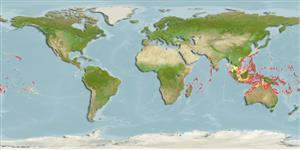Actinopterygii (ray-finned fishes) >
Scorpaeniformes (Scorpionfishes and flatheads) >
Scorpaenidae (Scorpionfishes or rockfishes) > Scorpaeninae
Etymology: Scorpaenopsis: Latin, scorpaena = a kind of fish, 1706 + Greek, opsis = appearance (Ref. 45335). More on author: Ogilby.
Environment / Climate / Range
Ecology
Marine; brackish; reef-associated; depth range 1 - 80 m (Ref. 90102). Tropical, preferred ?; 35°N - 25°S
Pacific Ocean: northwest Australia, Moluccas, and Philippines to the Marquesan and Society islands, north to Ryukyu Islands, south to Rowley Shoals, Western Australia, and Tonga; Mariana and Caroline Islands in Micronesia.
Size / Weight / Age
Maturity: Lm ? range ? - ? cm
Max length : 13.6 cm TL male/unsexed; (Ref. 90102); common length : 10.4 cm SL male/unsexed; (Ref. 37816)
Short description
Morphology | Morphometrics
Dorsal
spines
(total): 12;
Dorsal
soft rays
(total): 9;
Anal
spines: 3;
Anal
soft rays: 5. Submarginal black band on inner pectoral fin surface complete; eyes relatively large; snout relatively short; hump on back less obvious as in S. diabolus; SL to 10.4 cm. No black spot nearly as large as eye on inner surface of pectoral fins. A narrow triangular black mark inside mouth at front of upper jaw behind teeth. Ascending process of premaxilla broad, its maximum width 1.4-1.8 in orbit diameter. No series papillae or nodules across interorbital space between supraocular spines. Nasal spine single (Ref 42181).
A rare inhabitant of mixed sand and rubble areas of reef flats and shallow lagoons. Feeds on fishes (Ref. 89972). Usually buries itself in the substrate when in sand or sits amongst rubble where it has good camouflage (Ref. 48635). Anterolateral glandular grooves with venom gland (Ref. 57406). Solitary or in pairs (Ref 90102).
Life cycle and mating behavior
Maturity | Reproduction | Spawning | Eggs | Fecundity | Larvae
Myers, R.F., 1991. Micronesian reef fishes. Second Ed. Coral Graphics, Barrigada, Guam. 298 p. (Ref. 1602)
IUCN Red List Status (Ref. 115185)
CITES (Ref. 94142)
Not Evaluated
Human uses
More information
Common namesSynonymsMetabolismPredatorsEcotoxicologyReproductionMaturitySpawningFecundityEggsEgg development
Age/SizeGrowthLength-weightLength-lengthLength-frequenciesMorphometricsMorphologyLarvaeLarval dynamicsRecruitmentAbundance
ReferencesAquacultureAquaculture profileStrainsGeneticsAllele frequenciesHeritabilityDiseasesProcessingMass conversion
Tools
Special reports
Download XML
Internet sources
